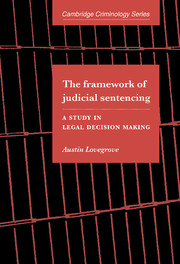Book contents
- Frontmatter
- Contents
- List of figures
- List of tables
- Acknowledgments
- 1 Judicial decision making and sentencing policy: continuation of a study
- 2 A sentencing decision model: single and multiple similar counts
- 3 A sentencing decision model: multiple disparate counts
- 4 Testing the decision model for multiple disparate counts
- 5 The techniques of data collection
- 6 Judges' thoughts on sentencing the multiple offender
- 7 An alternative sentencing decision model for the multiple offender
- 8 Validity and development of the alternative decision model: the data collection
- 9 Towards a requisite decision model for sentencing the multiple offender
- 10 The armature of judicial sentencing
- Appendix 1 Case 37 from Sentencing Research Exercise – Part 3B
- References
- Index
9 - Towards a requisite decision model for sentencing the multiple offender
Published online by Cambridge University Press: 22 August 2009
- Frontmatter
- Contents
- List of figures
- List of tables
- Acknowledgments
- 1 Judicial decision making and sentencing policy: continuation of a study
- 2 A sentencing decision model: single and multiple similar counts
- 3 A sentencing decision model: multiple disparate counts
- 4 Testing the decision model for multiple disparate counts
- 5 The techniques of data collection
- 6 Judges' thoughts on sentencing the multiple offender
- 7 An alternative sentencing decision model for the multiple offender
- 8 Validity and development of the alternative decision model: the data collection
- 9 Towards a requisite decision model for sentencing the multiple offender
- 10 The armature of judicial sentencing
- Appendix 1 Case 37 from Sentencing Research Exercise – Part 3B
- References
- Index
Summary
The fictitious cases were formulated and administered, as described in the previous chapter, with two ends in mind: (1) the delineation and quantification of the functions relating the variables in the alternative decision model; (2) the testing of this model's validity. Now, the strategy adopted to do this depends on the nature of the model under test – specifically, what is being claimed for it (the knowledge it represents) and what is required of it (the role it has to play). The purpose of the present chapter is to develop and justify an appropriate notion of model and apply it, within the limitations of the study, so as to move towards the above two goals.
The idea of requisite modelling
It will be recalled that only two of the judges in the present sample were able to articulate a relevant, general and coherent policy in considerable detail and with some consistency across the sentencing problems; moreover, from the manner in which these two judges gave their responses even they appeared to a significant extent not to be applying a ready solution but to be formulating on the spot what seemed appropriate by way of approach. And, in this respect, the best that can be said of the other judges is that, to the extent and on the occasions that it was possible to discern elements of a general approach to this type of sentencing problem in their responses, they were consistent with those of the former two (see Chapter 7).
- Type
- Chapter
- Information
- The Framework of Judicial SentencingA Study in Legal Decision Making, pp. 204 - 249Publisher: Cambridge University PressPrint publication year: 1997



